|
Hello group. My name is gravity, and I am addicted to coffee. Feel free to post "How can I make my lovely coffee moderately palatable?" type posts, but also be prepared to read replies from people who spend way too much time and money achieving the perfect shot.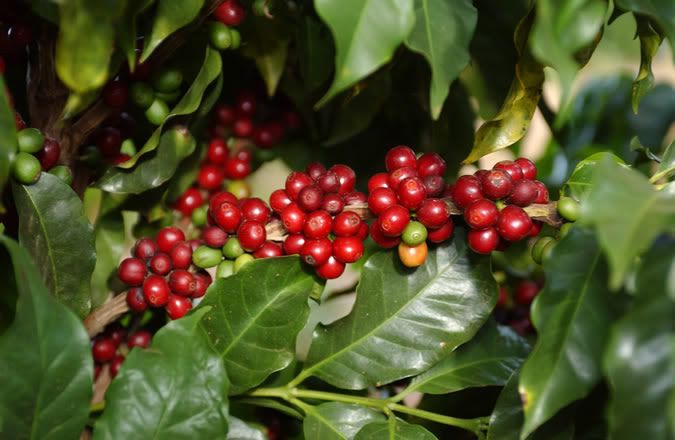 Coffee comes from the seed of a fruiting bush grown in abundance all over the world on practically every continent, save Antarctica. Though there are over 90 species of coffee, there are only four species of coffee that I have ever tried, and only two of which see large scale production: Species Arabica – The earliest cultivated, most widespread, and “best tasting” coffee (in many people’s, including my own, opinion). This variety actually has the least caffeine of the two varieties. Arabica tends to have smaller beans and will be slightly more expensive per pound, which is why you may see some blends brag about being 100% Arabica. This is because many cheap blends contain: Robusta – The filler coffee. Admittedly, it’s not really that bad, but it gets a bad rap because it is easier to grow, fruits prolifically, and produces bigger beans, all without being particularly remarkable in flavor or aroma. What robusta does bring to the table is a higher caffeine content and a more viscous mouthfeel, the latter of which can translate into better “crema” production in espresso, so you will often see robusta show up in espresso blends. Origin Coffee can also be categorized into three groups by style, then further into subcontinental regions and eventually by country. * Latin American, Carribean, and Hawaiian Coffees tend to be “normal.” That is to say, the flavor and aroma of these coffees are what many people think of when they think of coffee. They are usually pretty balanced in profile but can still be quite robust and have a refined sweetness. The most sought after of all coffees come from this category such as Jamaican Blue Mountain and Hawaiian Kona. * African Coffees are bright, lively, and rich. Some people call them wine-like, a description most often given to Kenyan coffees. They can also have a spiced or herbal nose as is the case for Ethiopian Yirgacheffes. * Asian-Pacific Coffees are thick bodied, earthy, and have a rustic sweetness. They are really popular in the modern craft coffee scene as their earthiness takes to dark roasts particularly well. Varieties such as the Sumatran and New Guinean coffees are notable for this. "Process" The separation of the coffee fruit or "cherry's" flesh from the seed largely falls into one of two categories or some hybrid of the two: Dry Process coffees' cherries are harvested, sorted, cleaned, and set in the sun to dry, being turned often and taking up to a month to dry. The seed is then removed with a hulling machine. Dry process coffees tend to be more "rustic" tasting, fruitier, and can be a bit inconsistent to roast. Wet Process cherries are harvested, and sorted by using water, bad cherries float. They are then hulled by forcing through a screen, and fermented in its own moisture to allow enzymes to break down the mucilage, a gooey outer layer on the seed. The mucilage is then washed off and the coffee is dried in the sun. Wet process coffees are more consistent to roast and are cleaner and more "refined" tasting. Semidry processing is a mix between the two. It utilizes hulling machines directly after harvest then allows for fermentation of mucilage, followed by minimal water washing, and drying. Semidry processing is relatively new and is only done in a few places, coffees tend to have the consistency and clean taste of wet process coffees, with the liveliness of dry. __________________________Roast Levels__________________________ Aside from origin, the roast level of the coffee has a huge impact on the coffee’s in-cup flavor. City, American, New England Light-medium to medium brown in color, this roast is, generally, the best roast to taste the difference between regions as these differences will be obscured further and eventually completely the longer the coffee is roasted. Coffee roasted to a city roast tends to be grain-like sweet, and bright/acidy. Full City, Continental, Viennese Medium to medium-dark brown in color, this is my favorite roast as it still represents the varietal flavor with a nice backbone of roast flavor. Full city roasted coffee is still lively, but some of the acidy edge is rounded off giving way to a light sweetness. French Dark to deep dark brown in color, at this roast level only the most robust varietal flavors are left, all of the nuanced tones, the liveliness, and the regional distinction has been roasted away. If I have a batch of green coffee I don’t care for the taste of, I will usually roast it to a French roast. French roasted coffee is mildly pungent, sweet, full bodied, and with nearly imperceptible acidity. Starbucks Deep dark brown to black in color, this roast level is about one notch away from charcoal. There is no varietal distinction; all coffees roasted to this level taste more or less the same. Starbucks roasted coffee tastes like burnt rubber. __________________________Brewing Methods__________________________ Drip machine. The most widespread method for brewing coffee, I’m sure. This method often relies on poorly designed heaters that begin to drip slightly warm water over coffee grounds. The heaters ramp up and eventually reach a temperature that is too hot. The coffee drips into a glass carafe that is placed on a heating element that is also set to be too hot causing the coffee to have a burnt taste. Some machines have stainless steel vacuum carafes that forego the carafe heater. If you must have a drip machine, get one of these. Resist the urge to use a gold tone metal filter. You defeat one of the biggest strengths of this brew method, the clean, sludge-free cup. Good paper filters have little to no “paper taste,” and if you combine with pre wetting, the “paper taste” should be non existent (with good quality filters). If you can swing it, get a Technivorm.  This is the Rolls Royce of drip coffee makers. They are hand made in the Netherlands, they have spray heads that evenly wet the coffee grounds and that don’t start spraying until the water has reached the correct temperature. They are completely dismantle-able for cleaning and maintenance. Get one. Drip machine pros: Convenient, clean cup Cons: Cheap models have no temperature control, there is no steep time control, heating elements can make coffee taste burnt, good models are big and take up a lot of space. Edit: For those considering getting an automatic drip, consider the Bonavita http://www.clivecoffee.com/product/...l_coffee_maker. K-Cup, Keurig, Single serve pods, etc. 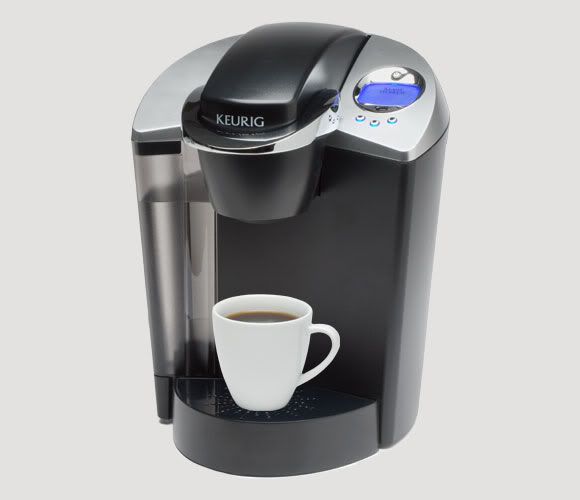 A relatively new thing to come on to the market. They advertise quality, convenience, and environmentalism and deliver on none of them. Read this: http://www.dearcoffeeiloveyou.com/love-keurig-nope/ Pros: You'll get a lot of comments at the office about how trendy you are, I guess that's a pro. Cons: All the cons of a cheap drip machine. Poor quality coffee pods that you over pay for. Lots of plastic waste. Pour over 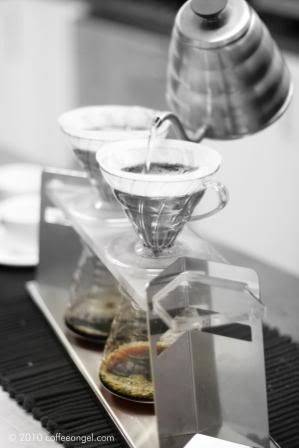 A drip coffee method where you are the “machine” part. This allows you to have precise temperature control with an electric kettle and an instant read thermometer. Examples: Hario V60 02 Clear ($8, needs proprietary filters), Chemex ($30, needs proprietary filters) Pour over pros: CHEAP, small, cheap, ability to have very accurate temperature control, clean cup, did I mention cheap, yeah it’s cheap. Cons: Requires you to actively brew the coffee, no full immersion or steep time control, requires a hot water source such as an electric kettle. Pour overs COMPARED: Melitta: the classic.  The cheapest, easiest to find, and easiest to find filters for. One small hole at the bottom restricts flow of the coffee just enough to make extraction almost fool proof. Uses standard cone-type filters. There are variations on this type of brewer such as the beehive which has 3 holes. Not really all that different, just drains faster, which can either be a pro or a con depending on your technique. Hario V60: the sperglord's choice.  Super thin proprietary filters, deep cut spiral ridges, one gigantic friggin hole at the bottom. This is probably the most finnicky of all the filtercones since it drains so fast. Because of this, improperly brewed cups will tend to be under developed, but on the plus side, you have to try really really hard to overextract in one of these. Many argue that you NEED to have a gooseneck kettle to get any kind of consistency from these. Chemex: the geezer.  This brew method has been around for a long time now. An hourglass shaped carafe with wood around the waist to keep you from burning yourself holds a nestled quadrifold circle or square filter. Super thick proprietary filters give you the cleanest, smoothest cup of all of the pourovers. This comes at the expense of more paper taste in the cup (though this can be avoided by rinsing the filter multiple times). Kalita Wave: the new kid.  Proprietary filters with a flat bottom and 3 drain holes. This is the newest darling on the scene and it has its fans who claim that it provides a cup like the V60 with less finnickiness. It also has a specialty kettle, though I would probably just get a gooseneck. Press pot, French press 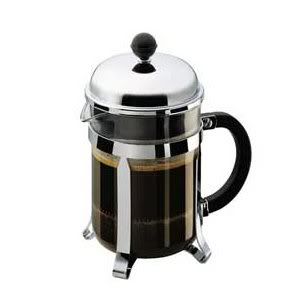 A full immersion coffee brewing method where coffee is brewed, then the grounds are separated by using a mesh screened “plunger.” The result is a very flavorful and nuanced cup of coffee that still has many of the volatile oils since it has not passed through a paper filter. Examples: Bodum Brazil 8 cup (no nonsense, black plastic) ($20), Bodum Chambord 4 cup (prettier w/ metal and stuffs) ($35) Press pot pros: Accurate immersion time and temperature control, no paper filters, modestly priced. Cons: Requires hot water source, cups brewed with a press pot are almost always murky or sludgy, can cause cholesterol spikes for people with cholesterol problems, carafes are quite fragile. Clever Coffee Dripper 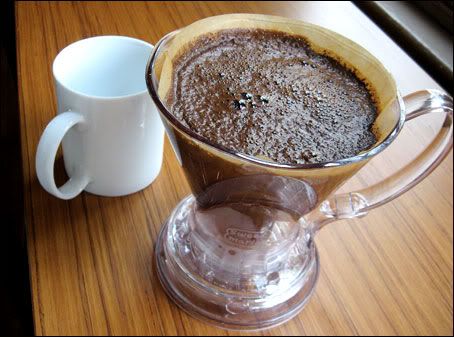 My personal favorite morning cup maker. This method is basically a pour over with a stopper on the bottom. It effectively blends the strengths of both pour over and press pot, with none of the weaknesses, except the convenience, I guess… The stopper on the bottom is very convenient, though. It activates anytime it is not on a cup, and when you place it on the top of one it releases the coffee. Pretty nifty. buy them here ($15): http://www.sweetmarias.com/sweetmarias/coffee-brewers/filtercones/clever-dripper-with-lid-2973.html CCD Pros: Immersion time and temperature control, clean cup, affordable. Cons: requires hot water source Aeropress 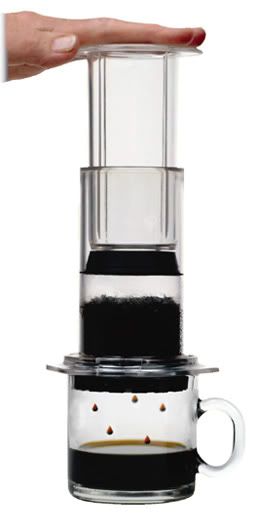 Kind of like an overgrown syringe that you place over your cup of coffee. Because you are actively forcing the water through the coffee grounds with pressure, coffee brewed in an Aeropress will have slightly different flavor than these previous ones (I guess they all will, technically, but Aeropress is the first one I’ve mentioned to have applied pressure be one of the variables). These are about $25 Aeropress Pros: Rich coffee, clean cup, Immersion time and temperature control, affordable Cons: Requires special filters that you usually can’t just go to the store to pick up, requires hot water source. Moka Pot 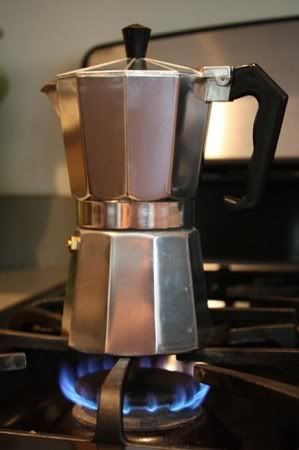 Often called a “stove top espresso maker,” moka pots brew small quantities of robust, rich, coffee. It is technically not espresso as the pressures at which a moka pot operates are quite low compared to “real” espresso makers. Nevertheless, moka pots brew great coffee and are perfectly fine for use in milk-based coffee drinks, or “Americanos”. Small ones run about $25. Moka Pot Pros: Small, affordable when compared to proper espresso machines Cons: Requires a stove, many don’t work on induction ranges, doesn’t make “real” espresso. Espresso Makers This is a big can of worms that I don't know that much about. Thanks to Bob_McBob for helping me write this section. Espresso makers tend to fall into 1 of 3 categories, then further into subcategories: Semi Automatic Machines These are the majority of the market. They have a steam wand and can cost anywhere from 50bux for a cheap POS up to thousands of dollars for a crazy multi head machine with a PID for the water temperature, and on and on and on... Thermoblock steam toys 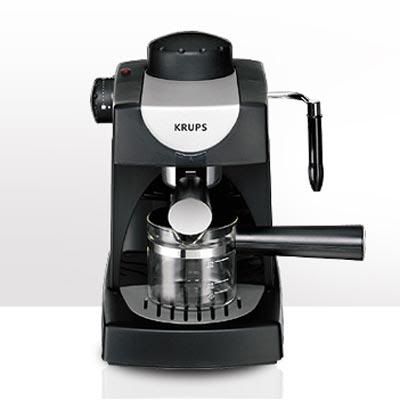 “fake” espresso makers are basically like cheap drip machines, they use heat to generate pressure which is often too low and inconsistent, they have poor temperature control, because pressure is generated with temperature the brew temp is too hot, they are made with cheap plastic parts, and have thin walled pressurized portafilters. If you are after espresso and are only willing to spend as much as these are, save your money. There may be an exception to this rule should ZPM Espresso ever release their project espresso machine which uses a custom thermoblock in conjunction with a PID for both pressure and temperature and with user customizeable shot profiling. They are about a year overdue for release though and though the promises are big, who knows if they'll deliver. Even if they do deliver, with a street price of $350, you're well into the price range of single boiler machines. Single boiler dual use machines 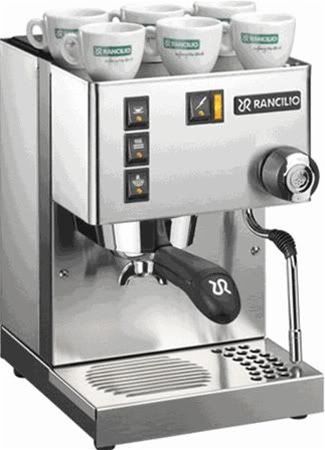 These have one boiler and a seperate pump that applies 15 bars of pressure to your puck of tamped ground coffee. Because they have one boiler, they require you to heat up the water for brewing then heat it again to use the steam wand. At the low end you have the Saeco Aroma ($230, but as low as $130 refurbished) and Via Venezia ($300). The nice thing about these is that SCG sells naked and unpressurized portafilters, should you desire to upgrade. The bad thing is they have lovely steam wands called pannarellos. You can also go as low as a DeLonghi EC155 and take a dremel to the plastic bottom of the portafilter to make it bottomless. People get good results with this, but because it is a lower end machine, the walls on the portafilter are thinner making temperatures fluctuate more and it also has a weird size which can make finding a tamper hard. There is a lot of plastic on this machine, too. At the top of this range is the beastly Rancilio Silvia ($630) which boasts a robust portafilter, sturdy construction, and a good steam wand. Some people say that this is the cheapest machine you should buy. For just a bit more is the Crossland CC1 which sports a nifty PID that helps alleviate one of the main problems with single boiler machines: temperature control. Heat exchanger machines  These have one boiler that runs at the higher steam temperature dedicated to making steam. It utilizes a heat exchanger to interface water en route to the brew heads and heat it up to temperature. Examples in this range are the Nuova Simonelli Oscar ($1000) and the Rocket Cellini ($1500) Dual boiler machines  These have two boilers so you can brew and use the steam wand at the same time both held at independent and stable temperatures, They often also have a lot more features like PID, hot water dispensing, industrial brewheads and steam pumps, etc. Examples in this range are the Rocket R58 ($2700), the Izzo Alex Duetto ($2250) and the Rolls Royce of home machines: La Marzocco GS/3 ($6500) Portafilters Pressurized portafilters are fitted with a device that makes up for lackluster grinding and tamping abilities and provides a sort of fake “crema”. Because of this, these are often called “crema enhancers”. Some argue that this is also not “real” espresso, but it’s closer than the moka pot and the thermoblock stuff. Nonpressurized portafilters lack the device that equalizes pressure in the portafilter, the result is a much more unforgiving pull, but when dialed in, produces “real” espresso. You NEED a good grinder if you want to make the most of this type of portafilter. A special type of nonpressurized portafilter is a naked/bottomless portafilter which just has a bare basket on the bottom. People like these because you can see the extraction happening and use the visual information to troubleshoot the brew variables.  Manual Machines 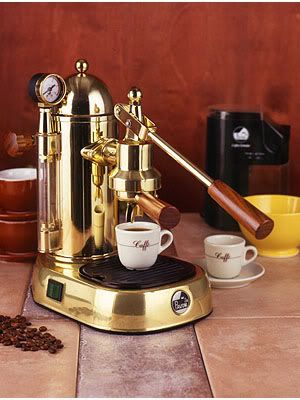 Manual espresso makers require you to be the pump. The beauty of a manual espresso maker is that, in the hands of a fantastic barista, they will pull the best shots you will ever have. Because they are manual they allow for finesse unlike the semi autos. They are expensive and most people will never use them, hell most people will never have a shot pulled from one by an experienced barista, and that is sad. Super Automatic Machines 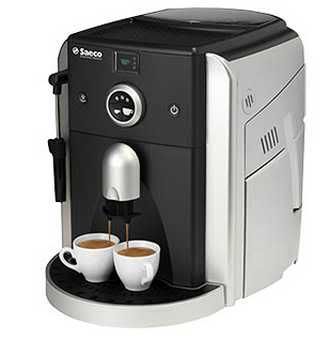 Automatic espresso makers do everything for you. They are very expensive and make pretty mediocre espresso shots. __________________________Extraction: the Big Picture__________________________  So I've hinted a few times about "properly extracted" coffee. There are 4 main components that determine how extracted your coffee is: Grind, Time, Ratio, Temperature. Photographers can probably understand this quite easily if I were to say that extraction is like exposure. Where in photography you can achieve "correct exposure" by dialing in various ISO, shutter speeds, and apertures, one can achieve proper extraction by dialing in the 4 extraction variables. Grinders 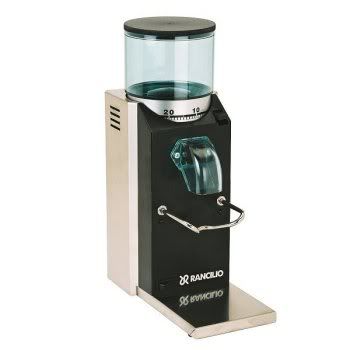 Quite possibly the most important thing when you are considering a coffee rig. Why? Well coffee is all about extraction but not everything in the bean is desirable on the palate. Many of us are familiar with the over extracted cardboard-like bitter taste of lovely office/diner coffee. Apart from just being lovely preground coffee, often a big contribution to the awfulness is that people use too little coffee to the amount of water they use which results in an overextracted cup. What does this have to do with grinders? Well different particle sizes of ground coffee extract at different rates. Smaller particles will become overextracted before large ones, therefore grind consistency is very important in coffee making. If you are looking at getting an espresso rig, you MUST NOT skimp on your grinder. Avoid blade grinders like the devil, they chop the beans instead of grinding them giving you a VERY inconsistent grind, the high speeds with which the blades rotate cause lots of friction problems which translates into lost volatile oils. Good grinders use nestled burrs that are spaced apart and that rotate at a slow rate. The result is an even, consistent grind. If you are looking for a grinder for pour over or press pot methods, a Baratza Maestro (refurb for $70, check the Baratza site often), Virtuoso (refurb for $143) or Capresso Infinity ($90) is usually a good choice. If you want an espresso capable grinder, buy the absolute best you can afford. Many people like the Baratza Vario ($400) and the Rancilio Rocky ($350). On the other end of the spectrum are manual grinders. I have one myself for my travel rig (yes I have a travel rig, I am aware I have a serious problem). Manual grinders are great because they are cheap and consistent. They are best mated to drip or press pot methods as coarser grinds are quicker to grind. Grinding for espresso or Turkish coffee with a manual grinder would seriously suck. I have a Hario Mini Mill Slim ($30), the Hario Skerton is also good. Funny story about the skerton, it is actually a typo (I am not making this up, or at least I heard it from the seattlecoffeegear ladies so blame them). Hario is a Japanese company, supposedly the original name is the "Skeleton," but apparently there were some problems in pronunciation...  (skerreton) (skerreton)  Ratios and the Importance of Scales There have been a lot of questions about ratios and most have a mention of how many "scoops" per "cup". This is a really inaccurate way of measuring coffee. Scoops are bad because there are different scoops, some coffee is denser than others, some beans are bigger than others and will fit in a scoop differently, some people are talking about ground coffee which is different still. Cups, you would think, is universal, but in coffee world some people use the 6 oz cup standard. No, the best way to dial in a ratio is to use mass (ok we're really measuring weight but I like grams and grams are a unit of mass). I prefer grams because 1 mL of water is 1 g and the ratios also come out prettier and easier to remember (as is usually the case for metric vs imperial). There is a great chart of ratios here: http://www.sweetmarias.com/grind.brew.php But really you only need to remember one number: ~18. The SCAA's guideline is for 177 mL of water, use 10 g of coffee. So if we were to take the ratio we'd get 17.7 or roughly 1:18 coffee:water. How do we use this? Well, place your favorite cup on your scale. Tare it. Fill up your cup to the desired level with water. Take a note of how much water that is and divide by 18. The resulting number is a good starting point for drip coffee methods such as various filter cones and Technivorm/Bonavita. If it's too weak you can tune from there, but this is also dependent on your extraction time and grind fineness so it will take some experimentation. For instance, I know that I take my V60 grind quite small by comparison to others. For French Press, I like about 1:17 for the grind size I use. So yeah, get a scale, preferably with at least 0.1 g resolution. They're not expensive, and you should be using them elsewhere in the kitchen, anyway. You can use it later in the brewing process (for pourover/french press) by placing the whole brew rig (cup, cone, rinsed filter) onto the scale and zeroing. Then you can add your ground coffee and crosscheck that you have the same mass you started with before the grind (you won't). You can redo your maths (if you care enough Temperature Ideal brewing temp for coffee is 195-205 F. There's a tiny bit of variation here, but as long as you're within the range you should be fine. You can get ~205F by bringing a kettle of water to a boil then letting it sit for a few minutes. Time Pourover aim for about 2 and a half minutes Press pot ~5 min drip/CCD ~ 6 min Aeropress/espresso ~ 30 sec __________________________Sourcing Coffee__________________________ 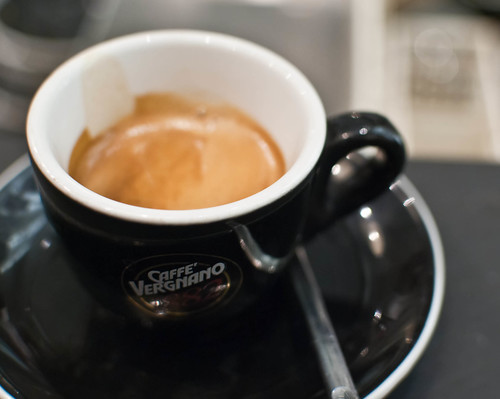 Coffee beans are very sensitive to how recently they were roasted. They “outgas,” letting off CO2 right after they are roasted, this CO2 makes a sort of “protective barrier” keeping the coffee from going stale. Because coffee outgases, it needs to be packed in special bags with one way valves. Once the coffee is completely outgassed, there is nothing protecting its oils from going stale or evaporating off. Optimally you should consume coffee within 2 weeks of its roasting. Coffee that comes vacuum sealed has been allowed to completely outgas, and was therefore already stale before it was vacuum sealed. If not, the act of sealing the coffee before it was done outgassing would give you a poofball of air and coffee. Store fresh roasted coffee in a sealed container, if it is truly fresh (as in roasted that day) keep the lid ajar to allow the excess CO2 to escape. Because you shouldn’t buy more coffee than you can consume in a 2 week period, it is important to find a local roaster. Local roasters ideally roast twice a week, though once a week is fine, too. Nice thing about local roasters is that you are supporting local business, which is also a good thing. There are also a few really good places to get fresh roasted coffee online, but it can get pricey, especially if you order from places like intelligentsia. If you feel the need to freeze your coffee you are arguably buying too much at one time. If you absolutely must freeze, try and use vacuum bag devices like foodsavers, and consume all the coffee before 2 months after the roast date, this is admittedly less than ideal. __________________________Roasting Coffee__________________________ By far, the most affordable way to get high quality roasted coffee is to roast it yourself. This may seem absurd to many of you, but the notion that you can go to the store to buy ready-to-brew coffee is only about 100 years old. Fresh, home roasted coffee fell by the hands of industrialization. Roasting coffee used to be a thing that everyone did once a week. These days coffee is a bland cardboard tasting brown granule that comes from a can. This is unfortunate, as home roasting is really no more of a chore than doing the dishes. The easiest way to get into home roasting is with either a stovetop whirley pop popcorn popper or a hot air electric popcorn popper. Both of which can be found at a thrift store for chump change. I, personally, use a stove top whirley pop. If you use an electric popper, use it outside, the flying chaff can be quite messy. Nice thing about the whirley pop is that it has a lid so the chaff stays contained. You also need two colanders. A fan and a spray bottle is also useful. Here is a useful guide! http://www.sweetmarias.com/roasting-VisualGuideV2.php Here is a guide on how to use a Stir Crazy to roast coffee (thanks scythide): http://biobug.org/coffee/turbo-crazy/ Method for stovetop poppers Heat the inside of your popper to 450F. Add coffee and start stirring. When your coffee has reached the desired roast level, take your popper outside and dump the coffee into one of the colanders. Pass the coffee back and forth between the colanders to allow the chaff to escape and to quickly cool the coffee. Doing this with a fan helps clear the chaff and cool the coffee. You can also spritz the hot beans with a couple of sprays of clean water. This is called water quenching. If you do this, note that you are not actually wetting the coffee, you are evaporating water off of the surface of the coffee; the act of evaporation absorbs heat from the beans due to the latent heat of evaporation. You really should only spritz 2 or 3 times. The coffee should not be wet. How to determine roast levels Using color to determine the roast of your coffee is quite inconsistent. The best way to determine doneness is to listen to it. Over the course of roasting, your coffee will undergo two periods of snapping and popping called the first and second “cracks.” As the first crack ramps up it will eventually reach a peak then trail off. If you allow the first crack to happen and stop immediately after it is finished you have roasted a “City roast.” As mentioned, City roast coffees are bright and lively, and retain the strongest origin character of the roast levels. Allowing the coffee to darken slightly past the city roast level is often referred to as City+ or C+. Stopping just shy of the first crack’s end is often referred to as New England roast. 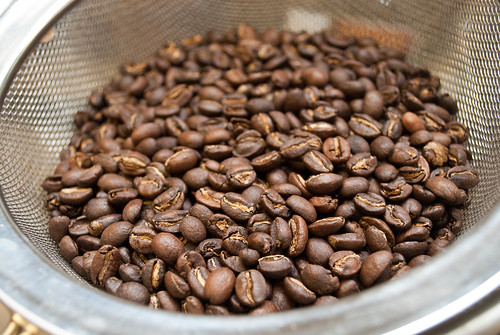 This is an Ethiopian Yirgacheffe roasted to about a C+ Allowing the roast to continue you will eventually reach the start of the second crack. Stopping when you hear the first few pops of the second crack will give you a “Full City” roast. As mentioned, Full City roasts offer good origin character with a bit of roast character. Allowing the second crack to actually develop for a bit longer gives you a Full City+ roast or FC+. 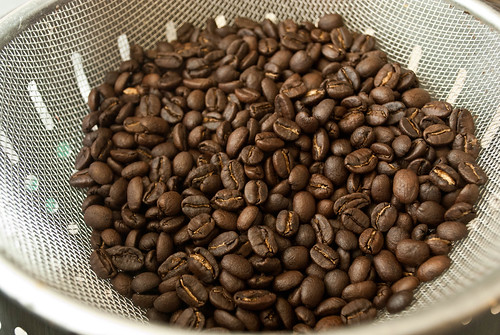 this is a Nicaragua Nueva Segovia, roasted to a FC Allowing the roast to continue to the point of a rapid second crack gives you a French roast. As mentioned, a French roast is almost completely roast character, only a few coffees can retain origin at French roast stage, Sumatran, for instance. Between FC+ and French is sometimes called Vienna roast. Just past French is sometimes called Italian or Spanish roast. 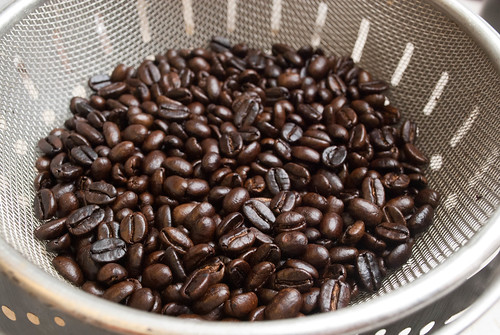 this is an Indonesia Sulawesi Toraja Sapan roasted to about a Vienna. Allowing the second crack to finish is a fire hazard, don’t do this. Stay tuned, more to come! Resources Green coffee beans, roasting information/gear: http://www.sweetmarias.com Green coffee beans: http://www.coffeebeancorral.com/ Espresso and coffee machines and supplies: http://www.seattlecoffeegear.com Great quality already roasted coffee: http://www.intelligentsiacoffee.com/ A list of great roasters! http://www.home-barista.com/coffees...ers-t12125.html Two goons who are trying to become full fledged roasters. Goon discounts! Fresh roasted coffee! click here: http://forums.somethingawful.com/showthread.php?threadid=3594506
|
|
|
|

|
| # ¿ Apr 19, 2024 22:03 |
|
Fuzzy Pipe Wrench posted:Thanks for the help guys! I think I'll start out with a cheap grinder (any suggestions for the cheapest I can get, to start, that'll be worth using? I'm ok with hand operated if need be. Also a french press to make it in because that way I get to keep more of the oils compared to the paper filters used with the clever coffee dripper. As for beans I'm going to probably order some online to start since none of the local popular shops seem to do their own roasting around here. The OP posted:If you are looking for a grinder for pour over or press pot methods, a Baratza Maestro (refurb for $70, check the Baratza site often), Virtuoso (refurb for $143) or Capresso Infinity ($90) is usually a good choice.
|
|
|
|
Cuttlefish Party posted:A no such thing for coffee, really, just buy the 70bux baratza maestro refurb, it's worth it in the long run.
|
|
|
|
Gravity Pike posted:Forever ago, I picked up a like $15-25 Black & Decker burr grinder. Is this Utter poo poo, Better than a blade-grinder, all/none of the above, etc? At the rate I drink coffee, something better would probably be a sound investment, but I'm not so sure for our friend who doesn't drink coffee that often. The biggest problem with blade grinders is that because the blades spin so fast, they don't actually grind the coffee, they chop it haphazardly. These spinning blades become a headache for good, consistent coffee making. I highlight consistent because, yes, you can make a good cup with a blade grinder, however press pot coffee will be very sludgy, proper espresso is impossible, moka pot will probably clog more often than not, and achieving proper extraction is a crap shoot. In addition, the blades move so fast that they start to heat the coffee which can destroy volatile oils. Now it's also important to know that coffee isn't purely "extract everything you can out of this bean." If that were the case, blade grinders wouldn't be so bad, however "overextraction" is definitely a thing. There are flavor compounds in a coffee bean that give you that cardboard-like, stale popcorn flavors, to bitterness and so on. It just so happens that these compound are only extracted en masse when certain extrema are hit. A few of these have been mentioned, extremes of temperature and extraction time, however it is important to note that extraction time is dependent on grind size. This is why a lot of coffee people fap on and on about grind consistency. With a blade grinder, you run the whole gamut of grind sizes from medium large chunks to fine powders, and this makes establishing a brew time for consistent extraction impossible. Anyway, that's the long, the short is, I'm willing to argue that any burr grinder is better than any blade grinder, if only because you bypass the speed of grind issue and the chopping particulate inconsistency issue. Now what you get with a cheap grinder is cheap parts. Sometimes these grinders' burrs will rub when grinding fine, which shortens their life, there will often be a lot of plastic parts, and I mean important plastic parts, not just cases. Sometimes they will sacrifice other things like grind size steps, etc. So yes, your grinder is better than a blade, but not better than, say that Maestro.
|
|
|
|
betterinsodapop posted:whirly blade grinder...French press  MMMMMMM If you have to go with a blade grinder, do yourself a favor and stick to pour over.
|
|
|
|
betterinsodapop posted:I've already taken it apart quite a bit, as instructed. I really don't want to remove the case and get into troubleshooting motors and electrical bits for a few reasons. I've no experience in that sort of thing and am afraid I'll irrevocably damage the machine. It's not really because I'm "too lazy" to do it. I've done absolutely all of the troubleshooting they've asked of me up to this point, but I'm not a goddamn engineer. As mentioned, you should really just have told them that it is under warranty and that you aren't comfortable taking it apart. Baratza actually has one of the best customer service reputations in the industry. I think you're overreacting.
|
|
|
|
Mr. Wiggles posted:Nobody? Anybody? Their website says they add a bit of cocoa, too. Maybe try some nibs?
|
|
|
|
djbaseball24 posted:am I wrong for loving my Keurig? yes
|
|
|
|
The problem with Keurigs They are sold under the premise that you can brew single cups of quality coffee with little mess (pods) anytime. They have no temperature control or steep time control, they are basically miniaturized drip coffee machines. The coffee has been roasted who knows when and ground around that same time. These go completely against the notion of a quality cup. Therefore the Keurig does not brew a quality cup. A common retort is that they make a filter basket insert for Keurigs, but this just negates the convenience factor of a disposable pod, all the while you overpaid for a lovely drip coffee system. A single cup french press or a cheap rear end pour over costs 1/4 to 1/10 the price of a Keurig and makes significantly better coffee. Or you can just get a MrKrupsinart cheapo drip system for 1/3 to 1/2 the price of a Keurig and put significantly higher quality coffee in it, without the mark up of pod-ization, and brew a better cup. GrAviTy84 fucked around with this message at 20:39 on Oct 29, 2011 |
|
|
|
MoosetheMooche posted:Can anyone chime in on how effective the Aeropress is? I read the OP but I'm still not sure if it's worth it. My brother's a big coffee fan and currently uses a french press. I'm wondering if there will be a significant increase in quality of his coffee (he already buys fresh roasted beans and has an expensive grinder). Saying an Aeropress is "better" is a bit misleading. It is very different from press pot and pour over.
|
|
|
|
As a Capresso Infinity user myself, I recommend the Baratza Maestro refurb. It is cheaper, has a better container (anti-static), more grind size quantizations, and has better burrs. Only reason I got the Capresso was because I had store credit at BB&B and they don't carry Baratza.
|
|
|
|
that Vai sound posted:Edit: Is it normal for burr grinders to be difficult to clean? The one I'm borrowing has buildup of old grounds, and I can't seem to get rid of them. grind up some rice in the grinder.
|
|
|
|
that Vai sound posted:
sbux and Solis grinders are all made by baratza
|
|
|
|
lousy hat posted:As a side note, if you have access to hot water for tea or whatever, the AP's about the most work-friendly coffee maker I've seen. Way better than the K-cups they've got at the office. I think cleanup is less messy and even faster with the CCD, believe it or not.
|
|
|
|
PainBreak posted:Do you not have a deck / patio thing at all? With a Whirley Pop, a heavy gauge extension cord, and a $10 hot plate from Walgreens, you're set to roast outside. Roasting on a patio with a $10 hot plate in New York in winter would be pretty tough to do. I don't think those things put out enough heat for that sort of thing.
|
|
|
|
nm posted:Are you sure? Here in friggin Redlands we have 2 roasters. I would imagine closer to civilization you'd have soemthing. HI INLAND EMPIRE BUDDY o/ Yeah, there's gotta be somewhere around there. There are four Intelligentsias in north LA, which I know is quite a drive for you, but if it's any indication there should at least be a small ma & pa place. A quick google search says there's a place called Catalina Coffee in Redondo, maybe try there?
|
|
|
|
Doc Faustus posted:With a $30 stovetop pot, a handheld frother, and some pre-ground espresso from a reputable roaster, am I going to get close to what I'm looking for? Yeah, moka pot, a frothing means of some sort(you can use a press pot). I would definitely suggest a grinder if you can afford it. If you must use syrups, use Monin, they make the best ones IMO. Just out of curiosity, why do you think lattes with syrups will be better for you than soda? You're just replacing a sugary drink with a slightly less sugary drink with fat.
|
|
|
|
rockcity posted:You'd also be surprised that the better the coffee is, the less additives are really needed. This. Most coffees you get from starbucks or whatever have all of the nuanced sweetness roasted the gently caress out of them. A cup of perfectly roasted coffee has plenty of the body, complexity, and sweetness that people try to doctor up for.
|
|
|
|
the problem with both is that they have a single point where the whole mechanism is held together. This causes play in the burrs which gives you some sloppy grinding. There are many hacks that are very easy and cheap that get around this, though.
|
|
|
|
hotsauce posted:What "number" should I put my Baratza (starbucks version) grinder on for an Aeropress? depends on how it's calibrated. That is actually pretty popular mod to do in order to use a maestro for espresso grinding, you can change the baseline closeness of the burrs by sacrificing the coarse end. Anyway, what "number" you should put a grinder on for anything is kind of a loaded question. It depends on the coffee, it depends on the calibration of the machine as mentioned, it depends on your personal preference within the "proper" extraction range. I would start around the medium range of whatever you would consider "fine" and work around that. Under extracted? go finer, and vice versa.
|
|
|
|
Fuzzy Pipe Wrench posted:Had espresso finally at my favorite local coffee shop. They have all the right things, but it came out really bitter with almost no crema and much too bitter How spergy/nice are they? If they are very friendly and care enough, you can help them diagnose the problem. Watch them pull a shot, how much coffee they use, see how they tamp the coffee, count how long it takes to pull. Sounds like they're over extracting by not using enough coffee and not tamping hard enough, also the lack of crema is usually a strong indicator of old beans.
|
|
|
|
AriTheDog posted:Thanks for the info. You're right that it's pretty minor, but the fact that no one took a look at the grinder and said "hey, wait a minute" before boxing it up and shipping it out says a lot about how they do things. There's clearly no check list, so screw ups like this are bound to happen. Not the kind of company I'd want to give a few hundred dollars to. How coarse are you talking about. You shouldn't be using gravel for press pot.
|
|
|
|
Clanpot Shake posted:Not to mention incredibly wasteful. What's the environmental toll on a case of those plastic pods every week? Linked earlier in this thread, a fantastic read for anyone considering a k-cup machine. Basically boils down to the advertised quality, ease of use, and environmentalism of k-cups are all lies. http://www.dearcoffeeiloveyou.com/love-keurig-nope/ I will put it in the OP.
|
|
|
|
Lord Dekks posted:Not disagreeing with them, but seems a bit silly to say don't use them because of waste, when that could be applied to just about everything we consume, may as well say never buy cereal unless its from a scoop your own shop and you use your own container, or only buy ground beef from a butcher wrapped in paper because of the plastic/styrofoam container. Waste is but one point, but sure, get fixated on it. It's just that it's wasteful, it's that they claim that they're environmentally sound, when they're not. aside: and you really should do those two examples you listed as outlandish. They're not. Local grocery has some really good granolas in their bulk food section, way cheaper and healthier than most box cereal. But alas, I rarely eat cereal. Buying from a butcher is a better practice overall because you're supporting small businesses, you get their expertise, you can pick the cuts you want to go into your grind and the tailor the fat/lean. quote:I don't own one, but we used to have a K-Cup brewer at a place I previously worked at and for a capsule/pod machine it wasn't bad tasting at all, obviously a pod machine is never going to compare to freshly ground etc, but its hardly the devil either. For the same price you can have some of the consistently best coffee money can buy. That they are swindling people into buying a lovely product under false pretenses makes them the devil indeed.
|
|
|
|
Loucks posted:How durable is the Hario Mini Mill? I need something to take to work daily but not leave there, and I don't want to have to buy another one in 6 months. I use one when I travel for business and it hasn't broken in over a year now, travelling by plane or driving long distance at least two times a month. I keep it in the box it came in during transport.
|
|
|
|
seravid posted:Help me, goons, for I have tasted this quality coffee you so praise and... it was pretty drat bad. How dark is the shakiso roasted to? Taken too dark, you could get burnt flavors no matter how you brew it. Also, the minimill can have a bit of problem with grinding coarser grinds without modification. This has been discussed a bit, but basically, the inner burrs are only attached at one point along the shaft and this causes a lot of play as you turn the crank, resulting in many large particles and fines. Modding is easy enough though, and cheap. Inconsistent grind can lead to the finer particles being over extracted, larger ones, under.
|
|
|
|
rockcity posted:I thought bitterness is often a relation to extraction time, usually meaning it was too slow and you'd want a coarser grind. It might just seem bitter because it didn't extract enough so you're not getting the enough of the coffee flavor with it in which case, yeah, go finer. Bitterness can be related to extraction time, but can also be related to too fine of a grind, and too little quantity of coffee used. Any photography people can think of proper extraction kind of like proper exposure. Like exposure there are independent variables that can be adjusted to acquire proper extraction. These are coffee quantity, grind size, water temperature, brew time. If the brewed coffee tastes overextracted this is usually due to too fine of a grind size with too little coffee, too hot water (rarely a problem with pour over), or too long of a brew time. Overextraction, to me, tastes watery, hollow, and has a bitterness that I can best describe as "cardboardy". The thing about acidity is also something to think about. It can be hard to decipher people's impressions of coffee as there is a such thing as a pleasant bitterness, that Bob_McBob is talking about, and a pleasant acidity (most often found in Africans and especially dry processed Africans, Kenya AA is notoriously acidy, sometimes called wine like) that rockcity is talking about. And there is such thing as bad bitterness (obviously) and sourness which can be construed as acidity. seravid posted:Thanks for the help, I'll try different grinds/temps/pour methods and see how it goes. Yeah, sounds overextracted. December 12th is also over a week ago, how was it stored?
|
|
|
|
seravid posted:Gave it another shot. I boiled the water, waited 3-4 minutes before covering the grounds, let it do its thing for 30 seconds then poured over (in a circular motion around the edge). Brew time was around 2 minutes (first time was 3+ minutes). Grind was coarser than previous attempt. I would go with a gently caress-it opposite direction brew next time. Grind finer than the first try, use 1.5x as much coffee, and pour slow, aiming for a 4 minute extraction. The thinking here is maybe the grinds were too coarse to begin with and the water is just passing around them without actually extracting much. This is one reason I really like the CCD, it's a lot more foolproof.
|
|
|
|
Don't worry about "monopolizing" the thread. If people wanted to talk about other things, they'd bring them up. We want you to brew a cup you'll enjoy 
|
|
|
|
Doh004 posted:
Congrats! Welcome to roasting. You don't have to wait. I do it all the time. Just grind and allow for more degassing time when you prewet, it will be pretty voluminous. Loucks posted:Also, I was given an air popper. Does anyone have any suggestions for good "beginner beans?" Congrats, too! "Peaberry" type beans are nice because of their shape. They roll easily and roast evenly because of this. Also wet process coffees have a tendency to roast more evenly because of the nature of the process. The size sorting is usually more consistent and there are fewer "quakers." Coffees that can take a large swath of roasts and still taste good are good as well, as your roast control will not be optimal at first. GrAviTy84 fucked around with this message at 22:01 on Dec 25, 2011 |
|
|
|
Residency Evil posted:I just got an aeropress for Christmas and I'm looking at burr grinders. The Maestro is up on the refurb store for $95. Any reason to get it over a Capresso Infinity or Bodum Bistro (http://www.amazon.com/Bodum-Bistro-Electric-Coffee-Grinder/dp/B0043095WW/ref=sr_1_3?ie=UTF8&qid=1324849088&sr=8-3)? I've got $40 in amazon gift certificates burning a hole in my wallet so I'd prefer one of the later two but I'll go for the Maestro if it's significantly better. The Maestro is significantly better. Better burrs, more grind steps, anti static container. It is worth it. quote:Or should I just grind my coffee at the store and use it a week at a time? If you can afford a grinder, don't do this.
|
|
|
|
Gravity Pike posted:Is there a point at which grinding your coffee right before you use it isn't going to do much to save it? My parents got like 10 pounds of coffee from Costco, and immediately put it all in the freezer. I am not going to be able to convince them to get better coffee, or put in a modicum more effort than it takes to dump grounds into the top of a Mr. Coffee in the morning. Are they going to see any benefit from using fresh-ground-correct-fineness coffee, or is that a waste of effort at this point? Depends on the coffee at costco. The used to sell these fresh roasted 2 lb bags, single origin (SO). It was pretty decent coffee. I stopped buying roasted coffee though when I started roasting I'm kind of unsure of what you're asking though. I think you're asking if the quality of the coffee is so bad and all other brew variables are bad, is optimizing grind worth it? I think it depends on who's drinking it. If you are on a crusade to get your parents into good coffee but they couldn't care less, I think you're destined to fail and I wouldn't even bother. If you think they could be swayed, I wouldn't even bother with baby steps. I'd show up with a modded skerton or mini mill, some fresh roasted coffee, and a CCD and do a good coffee full assault on the senses. Then when they  at the enlightening experience of a proper cup of coffee, getting them to get a 100bux grinder is a lot easier. at the enlightening experience of a proper cup of coffee, getting them to get a 100bux grinder is a lot easier.Edit: even if you get the cheap Costco "Jose's" brand, this coffee is still miles better than preground folgers/maxwell/yuban/whatever. I think proper grind treatment will still be noticeable. GrAviTy84 fucked around with this message at 00:11 on Dec 26, 2011 |
|
|
|
seravid posted:According to a thread back on CoffeeGeek, this appears to be pretty common. Nice going, Hario, I'm sure I'll buy more of your quality products in the future. To be fair, you're expecting 300bux of grinder out of a 40bux hand grinder. This is one reason many of us recommend buying the best grinder you can up front. HardCorey posted:Any strong opinions on reusable filters? Sometimes I feel guilty about all the disposable ones I go through. I like a clean cup and I compost. So I have no qualms with using paper filters.
|
|
|
|
hotsauce posted:Alright. I think I've found what will work for me. This is a solid non pressurized portafilter, single boiler machine and grinder combo. Know that there is a learning curve with a non pressurized portafilter, if you're ok with that, fire away! kirtar posted:(e.g. electric tea kettles perhaps) you answered your own question. I just have this Aroma brand one I got from Target for 22bux. Stainless steel, fast, works well.
|
|
|
|
seravid posted:Got my CCD I think you're starting to get too caught up in the physical aspects of the brew process. How did the coffee taste? Coffee looks a bit coarse to me, but then again you also have a lot of sludge in there (which would have shown up in the cup had you had brewed press pot), probably from your wobbly hario. Both of these are moot when talking about your slowed drain time because the thing actually slowing your drain down is the filter. 25-40 sec of drain time is perfectly acceptable. Don't freak out. These things are only worth pursuing if you don't like how the coffee tasted. So, how did the coffee taste? GrAviTy84 fucked around with this message at 19:45 on Dec 28, 2011 |
|
|
|
hotsauce posted:Ok, edit with a question. What's the general consensus on the best roaster that ships? I'm looking for less-oily beans that have that smooth chocolaty taste that great espresso consists of. Can't go wrong with intelligentsia or stumptown.
|
|
|
|
wildlele posted:I got a Technivorm Moccamaster KBT 741 for xmas and am now wondering about filters. The OP says to avoid gold plated filters, but if I don't mind cleaning it, what is the issue with it? I have some Costco #4 filters that I currently use with my old coffee maker, if I stay paper are those acceptable or would I need to switch to something different? Gold tone filters will result in a sludgy cup, also the cholesterol thing, if you care about it.
|
|
|
|
dema posted:Yeah, neither have I. Not cheap but good stuff. a thermometer.
|
|
|
|
icehewk posted:You can buy an insert for the Keurig that allows you to use your own beans in French Press grind. These defeat the whole purpose of a Keurig: convenience and easy cleanup. If you're going to go out of the way to get your own coffee, might as well do pretty much any other brew method and make a significantly better cup.
|
|
|
|

|
| # ¿ Apr 19, 2024 22:03 |
|
seravid posted:My Brazilian coffee arrived. On the bag, a little description praises its "outstanding sweetness" with notes of chocolate, caramel and toffee. Sounds good to me. Do you ever taste other things like wine, whisky, rum, or tea? I mean taste, not just drink. These "notes" that descriptions like to brag about are just subtleties in the coffee, the coffee wont actually taste like a cup of toffee or caramel or hot chocolate or gingersnapcookies with wild berries. It tastes like coffee with a hint of fruitiness, or coffee with a caramel-like roastiness, or coffee with a rustic chocolate like earthiness, or coffee with a bright spicy nuance. These notes are just things that the cuppers, when cupping, think the coffee's subtleties remind them of. A vid on tasting vs drinking http://www.youtube.com/watch?v=npUErC5z9p4 some notes on cupping http://coffeecuppers.com/Tasting-Primer.htm
|
|
|





 . What are the odds other places in town that make less-good drip coffee would have better espresso?
. What are the odds other places in town that make less-good drip coffee would have better espresso?


